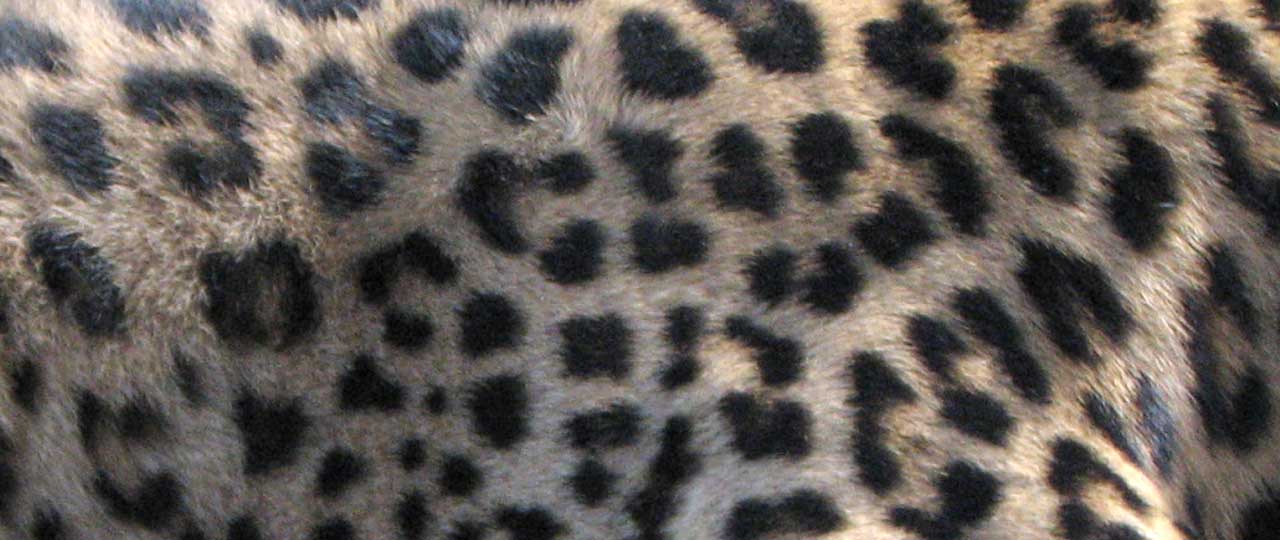
Leopards
Panthera pardus
Gypsy
Gypsy was not fond of most men. In order to get her to move from one place to another, all the males had to clear out so she would cooperate.
A Little About Leopards

Leopards are amazingly stoic creatures with a stare that is enough to stop anyone in his or her tracks. The nine sub-species of leopards can be found throughout Africa and Asia. While the climates may vary, most of these sub-species prefer habitats with many trees.
Their coloring differs based upon geographic location, but most commonly, their base coat color is a tawny gold with black spots know as “rosettes.” One genetic variation to this is the melanistic leopard (meaning an increased amount of black pigmentation in the fur). This is caused by parents who carry a recessive gene. Even though these leopards appear solid black, if you were to visit our melanistic resident, you would notice that they actually have the same black rosettes – just on a black background.

The rosettes are the key to differentiating between the leopard and another similarly-patterned big cat, the jaguar. While both have black rosettes, the jaguar’s tend to be larger and often have one or two small black spots inside them. The leopard’s, on the other hand, are smaller, closed, and tend to be closer together. The average weight of a leopard is 37 – 143 pounds (17 – 65 kg) while it can be from 5 – 7.5 feet (1.6 – 2.3 m) in length with the males being on the higher end of those measurements.
Leopards are nocturnal (night-time), carnivorous (meat-eating) predators. They tend to stalk and pounce on their prey rather than chase it like other cat species. NBA players would be jealous of the leopard’s vertical leap of over 9 feet (3 m), while any long jumper would love to have the ability to clear over 18 feet (6 m) with very little effort.

Like many other predators, leopards are opportunistic feeders – hunting whenever food is available. For this reason, they have quite a varied diet. They can be found consuming anything from insects, birds, and rodents to larger prey such as antelope, pigs, and even primates.
The leopard’s strength is what enables it to keep its prey safely away from the competition (lions, tigers, and hyenas) by carrying it up into trees. This animal is so strong that it can tackle and carry prey that is up to 10 times its own weight.
Overall, the leopard is currently listed on the International Union for Conservation of Nature and Natural Resources (ICUN) Red List as “near threatened” with habitat loss and hunting for trade being the biggest factors causing their decline. Even though they are the most widely populated of the big cats, five of the nine sub-species of leopards are considered critically endangered.
Sources:
Henschel, P., Hunter, L., Breitenmoser, U., Purchase, N., Packer, C., Khorozyan, I., Bauer, H., Marker, L., Sogbohossou, E. & Breitenmoser-Wursten, C. 2008. “Panthera pardus.” IUCN 2013. (Online) IUCN Red List of Threatened Species. Version 2013.1. August 03, 2013. <http://www.iucnredlist.org/details/15954/0>.
Hunt, A. 2011. “Panthera pardus” (Online), Animal Diversity Web. August 01, 2013. <http://animaldiversity.ummz.umich.edu/accounts/Panthera_pardus/>.
To see photos and read more information about our leopards, Cante and Gypsy, please visit their individual pages.


